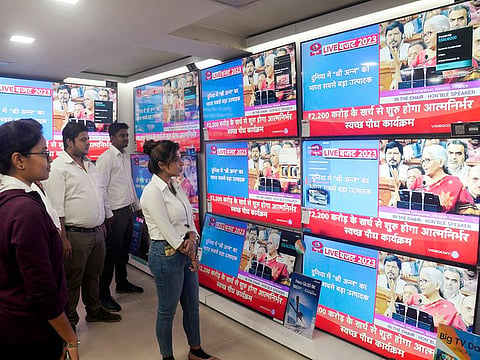India’s budget 2023 clearly had an eye on elections
The government aims to create jobs through a big push in spending with fiscal discipline

In India, Modi government’s 2023 budget was always going to be tricky balancing act, thanks to a global economic slowdown and domestic concerns like inflation. But there are also elections.
With polls to parliament just 14 months away and nine states and Jammu and Kashmir going to the polls this year alone, many experts were worried it would be a overtly populist budget.
In the end, it is not an outrightly populist budget but it is one that has tried to please many — like the middle class, women, tribals, and backward castes. It is a budget that aims to create jobs through a massive push in spending without hurting the government’s fiscal discipline. And this will be key ahead of next year’s Lok Sabha polls.
Brokerage Nomura issued a statement saying the budget has “pushed for growth via public capex and continued on the path towards fiscal consolidation, without offering much in terms of outright populism.”
New tax scheme
One big headline was of course the change in tax exemptions under the new tax scheme to please the salaried middle class. For years, the middle class has felt ignored in the budget while simultaneously being hammered by rising prices. Tax slabs haven’t seen a change since 2018.
Some experts have however pointed out that by pushing people to the new tax regime, safety nets provided through exemptions in the old scheme will be hit. This is the only social security net for millions. So the jury is still out on how this may play out.
The outlay for the Pradhan Mantri Awas Yojana, a scheme to build houses for the poor, was increased by 66% to over Rs79,000 crore. That’s up from Rs48,000 crores in the last budget. Subsidies and schemes for the poor have been a key aspect of the government’s election strategy.
The finance minister also launched new socioeconomic development schemes including one for tribals and another to support artisans from weaker sections and Scheduled Castes, Scheduled Tribes and Other Backward Classes. All of these groups are being aggressively wooed by the BJP ahead of the general elections.
MGNREGA takes a hit
However the Mahatma Gandhi National Rural Employment Guarantee Act (MGNREGA) has taken a huge hit with allocation to the rural employment guarantee programme being cut by 33%. Its being called a bloodbath by activists who say poor households will take a huge hit and face greater unemployment.
The other key vote bank the BJP has been wooing are women. So the budget announced a new small savings scheme for women as well as enhancing the maximum deposit level of a senior citizens saving scheme.
But the biggest announcement was the infrastructure push which has the potential to create many more jobs. Unemployment hit a three month high of 8% in November and unemployment has been a sustained concern for the economy.
In the budget, the government has raised its capital expenditure by 33% to 10 lakh crore rupees. There is criticism that this is an ambitious hike when the government was not able to spend all of the money allotted for the same in the last budget — Rs7.3 lakh crores was completed as against a target of Rs7.5 lakh crores.
But there are significant challenges that lie ahead. The budget comes at a time when there are recessionary fears across the world. There are also valid fears of a K shaped recovery in India’s economy — where the rich are getting richer and the poor getting poorer. How will these inequalities be addressed?
India may be heading towards being the fastest growing economy in the world, but the gap between the rich and poor is widening. The budget clearly had an eye on elections. Will it work? Watch this space.
Sign up for the Daily Briefing
Get the latest news and updates straight to your inbox



